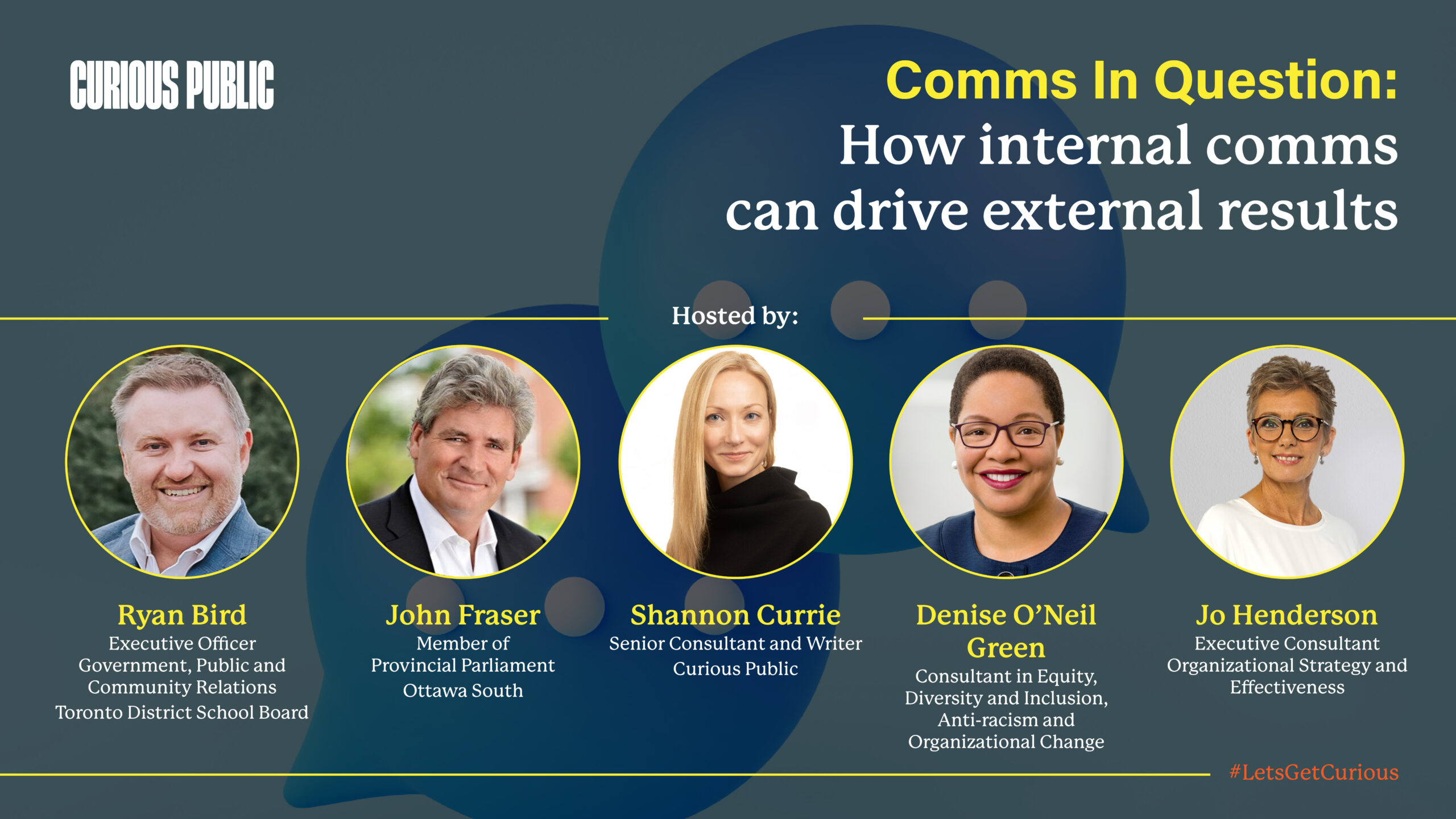“Received and understood” became a catchphrase of the day in our most recent episode of Comms In Question: How internal comms can drive external results.
Senior Writer and Consultant Shannon Currie hosted the discussion. She asked our panel of experts to weigh in on this often overlooked but important aspect of Communications.
Our guests shared insights on everything from overcoming email overload, to helping diversity, equity and inclusion goals, to decreasing the risk of backlash when internal comms go “outside the tent.” If you didn’t get a chance to join the discussion live, you can watch the recording here.
Panelist MPP John Fraser mentioned the goal of “received and understood” as the measure of good internal communications and as a means to ward off the dreaded response: I didn’t get the memo.
Interestingly, John’s phrase became a shorthand with panelists throughout the conversation to indicate the level of trust an organization earns with its communications. All of our experts agreed that internal communications is more than just “receiving” communications — it’s about understanding them, which comes from deeper, more nuanced, and more personalized communication. But as our panelists confirmed, trust breeds engagement, and engagement is the goal.
“The personal connection is always the best thing,” said Dr. Denise O’Neil Green, Equity, Diversity and Inclusion Consultant. “People respond to emails from folks they know and have a connection with – probably more so than those they are accountable to.”
What should success look like for your internal communications?
Our panelists shared what communications professionals should work toward when revisiting their internal communications plan.
1. Messages circle back
MPP John Fraser said we need to measure the quality of the communications with the quantity we hear back. As John explains, he knows that people have understood his message when he hears them adopting it as their own. And what’s John’s secret for creating messages that circle back?
“It’s the simplicity of the message,” he says. “And it’s also the repetition of the message.”
2. Cross-departments work together
“While Communications Directors are accountable for communications,” says Jo, “it’s the leaders and the managers who are responsible for communications … When [internal communications] is working perfectly, you have cross-departments working together.”
Executive Consultant and Leadership Strategist Jo Henderson reminds us that internal communications should be a bi-directional activity that cuts across organizational silos.
“While Communications Directors are accountable for communications,” says Jo, “it’s the leaders and the managers who are responsible for communications … When [internal communications] is working perfectly, you have cross-departments working together.”
Jo points out that organizational processes work across departments to ensure correct timing and engagement from teams, so communications shouldn’t be any different—in fact, that’s how Jo has witnessed increased engagement in organizations.
3. Trust and simplicity
Dr. Denise O’Neil Green calls for communication professionals to “keep it simple” but focus on trust. Throughout the conversation, Dr. Green reminded us that building relationships and trust is key to engagement. The pandemic and remote work have given us a suite of digital tools and channels, but Dr. Green shared that creating a strong foundation of trust goes much further than the latest internal messaging app.
“[Communications professionals] have the tools they need,” she said. “But it’s about trusting your people, trusting who they are, trusting your messaging and just keeping it simple.”
4. Accessible, human language
Ryan Bird advised communications professionals to avoid trying to please everyone with an internal communications plan. Rather, Ryan suggests prioritizing clear and accessible communication that sounds like a human wrote it.
Ryan is the Executive Officer of Communications and Public Relations for the Toronto District School Board – Canada’s largest school board – so he knows how challenging it is to get the message across and make it relevant and consistent.
“You’re never going to please everyone,” says Ryan. “I’d love to go for a hundred percent satisfaction rate, and sure, we’ll aim for it; but I can assure you we’ll never get it. I think just acknowledging that you’re not going to please everyone, but as long as you’re using simple language, understandable, upfront, honest language– like a human being talking to [another] human being… [and] if that message comes back around, then I think you’ve succeeded.”
Check out our full conversation to learn more.
Thank you again to our panelists, Dr. Denise O’Neil Green, Jo Henderson, MPP John Fraser, and Ryan Bird.
If you think it’s time to review your organization’s internal communications plan, let us help. Contact us today.
Shannon Currie
Senior Consultant and Writer at Curious Public.



